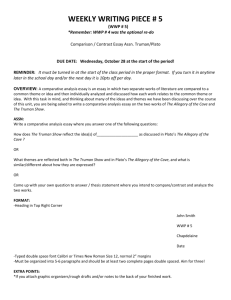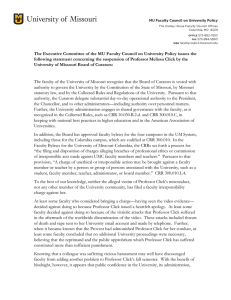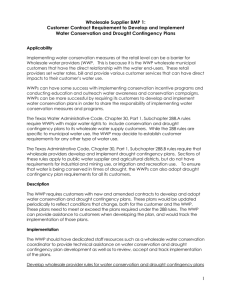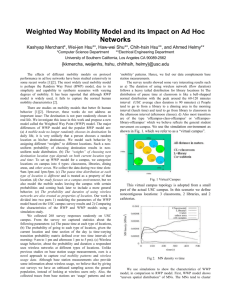The Value of Information in Inventory Management Gokhan Metan Aur´ elie Thiele
advertisement
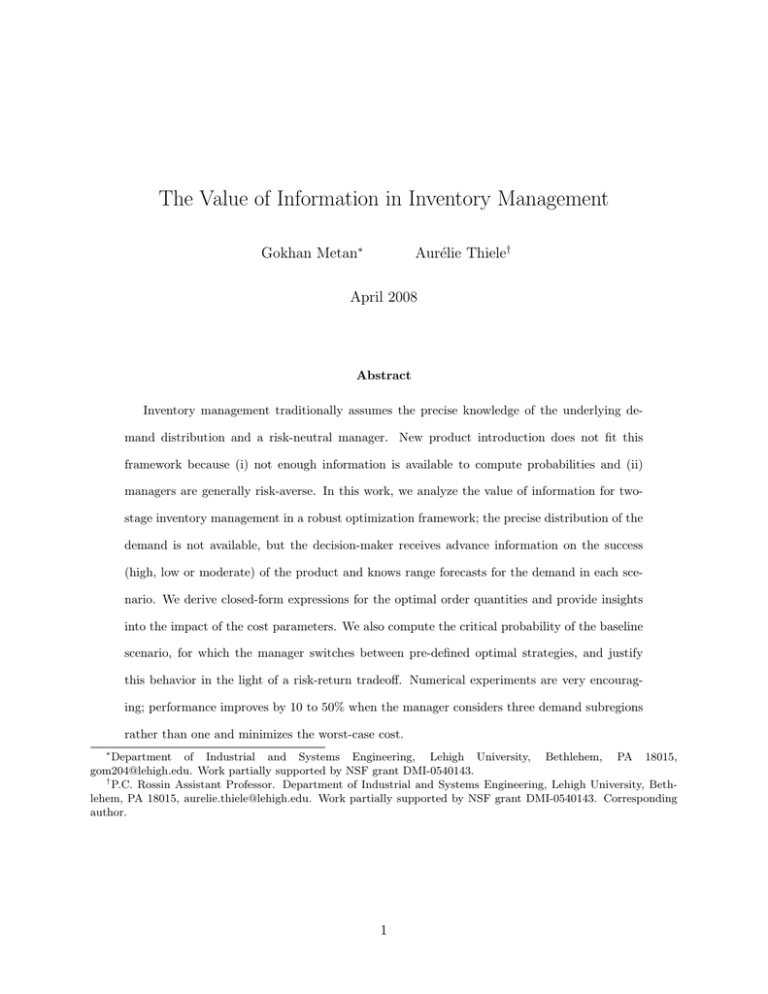
The Value of Information in Inventory Management
Gokhan Metan∗
Aurélie Thiele†
April 2008
Abstract
Inventory management traditionally assumes the precise knowledge of the underlying demand distribution and a risk-neutral manager. New product introduction does not fit this
framework because (i) not enough information is available to compute probabilities and (ii)
managers are generally risk-averse. In this work, we analyze the value of information for twostage inventory management in a robust optimization framework; the precise distribution of the
demand is not available, but the decision-maker receives advance information on the success
(high, low or moderate) of the product and knows range forecasts for the demand in each scenario. We derive closed-form expressions for the optimal order quantities and provide insights
into the impact of the cost parameters. We also compute the critical probability of the baseline
scenario, for which the manager switches between pre-defined optimal strategies, and justify
this behavior in the light of a risk-return tradeoff. Numerical experiments are very encouraging; performance improves by 10 to 50% when the manager considers three demand subregions
rather than one and minimizes the worst-case cost.
∗
Department of Industrial and Systems Engineering, Lehigh University, Bethlehem, PA 18015,
gom204@lehigh.edu. Work partially supported by NSF grant DMI-0540143.
†
P.C. Rossin Assistant Professor. Department of Industrial and Systems Engineering, Lehigh University, Bethlehem, PA 18015, aurelie.thiele@lehigh.edu. Work partially supported by NSF grant DMI-0540143. Corresponding
author.
1
1
Introduction
Inventory management has been widely studied in the literature when the distribution of the random demand is precisely known (Bramel and Simchi-Levi [2], Porteus [12]). Such probabilistic
approaches generally assume that the managers are risk-neutral. When a product is newly introduced to the market, however, the data needed to compute demand forecasts is scarce, which makes
it difficult to estimate probability distributions accurately, and over-reliance on wrong guesses might
yield dire outcomes. For instance, Honda announced in June 2007 that it would discontinue its
Accord Hybrid model after only three years of commercialization and cited management’s failure to
anticipate the importance of gas mileage, as opposed to horsepower, for hybrids-buying motorists
as the main reason for the car’s weak sales [18]; in the video game industry “Nintendo’s Wii is hard
to find in stores because the company miscalculated demand” [16]. Even well-established product
lines face significant sources of randomness: according to industry analysts, Dell’s global market
share fell by 8.7% to 13.9% in 2006 while Hewlett-Packard’s rose by 23.9% to 17.4%, because Dell
anticipated neither the move of U.S. customers from desktops to notebooks, nor the flagging sales
of business computers as companies evaluated Microsoft Vista ([5], [6]).
Moreover, managers often exhibit high levels of risk aversion due to their limited understanding
of the market response at such an early stage of the product lifecycle. Risk aversion is welldocumented in the portfolio management literature, but has also been observed repeatedly in the
operations management community: in June 2007, the Wall Street Journal devoted seven full pages
to an advertising section on “Perspectives on Managing Risk” [17], noting that “whereas risk was
rarely talked about in boardrooms five years ago, today it has come to the forefront of the agenda.”
A natural way to incorporate risk preferences in inventory management would be to use the same
approach as in finance and rely on the expected value of utility functions, which are nondecreasing
and concave in the objective. Unfortunately, utility functions are difficult to articulate in practice,
and thus are unlikely to be adopted by decision-makers. Researchers routinely assume utilities with
2
linear risk tolerance, such as power and exponential functions, simply because these are convenient
to manipulate; however, they might not capture the true preferences of the manager. A more
intuitive risk criterion, the probability that the objective exceeds some threshold, suffers from
tractability issues; computing this probability will in general require multi-variate integration. The
reader is referred to, for instance, Eeckhoudt et. al. [4], Lau [9], and more recently, Chen et. al. [3]
for studies of risk-averse inventory management.
A few practitioners have attempted to describe randomness in a non-probabilistic manner to
match the information at their disposal. Experts (see Nahmias [10], Simchi-Levi et. al. [13] and
Sheffi [14]) have identified the following two principles as fundamental to the practice of modern
management under uncertainty: (i) point forecasts are meaningless (because always wrong) and
should be replaced by range forecasts, (ii) aggregate forecasts are more accurate than individual
ones, as independent sources of uncertainty tend to cancel each other out. As an example, HewlettPackard has utilized these insights to decrease the cost of manufacturing its DeskJet printers;
production of the sure component of the demand – the lowest value of the range – is assigned to
a cheap, slow supplier in Singapore and production of the other units is allocated to an expensive,
fast plant in Vancouver once demand is revealed (Sheffi [14], pp.99-100). Such practitioners-driven
strategies establish the importance, from an industry perspective, of quantitative business models
that are tailored to the level of information available and suggest that descriptions of uncertainty
based on range forecasts are a pertinent alternative to probabilistic frameworks. Such a model
represents the central theme of our research.
The framework proposed here builds upon the following idea: although the manager is unable
to compute the demand distribution for a new product accurately, focus groups, advance orders,
reviews in the specialized press or other sources of information allow him to estimate a range
for the demand, as well as an interval within that range where the demand is likely to fall with
known probability. This modest amount of information can be utilized to divide the demand
region into several sub-intervals; here we consider three of them: low, moderate (baseline) and
3
high demand. Using three scenarios to represent demand stochasticity is a common assumption
in the practice-oriented inventory management literature (see Graves et. al. [7], Kim and Gunther
[8], Spengler et. al. [15]). Considering higher numbers of scenarios is possible, but in practice it
becomes more and more difficult to assess their probabilities accurately, which runs against the
purpose of the work. Benefiting from advance information, e.g., knowing in which interval the
demand will fall before it is realized, helps the manager improve system performance by adjusting
his strategy to the demand scenario while minimizing the worst-case cost in each demand region.
While range forecasts have become the cornerstone of decision-making under uncertainty using
robust optimization (Bertsimas and Thiele [1]), it is natural for practitioners to wonder how to
incorporate additional information beyond the demand support. The framework we propose here
complements the robust optimization approach to inventory management presented by Bertsimas
and Thiele [1] by (i) incorporating an element of adaptability and (ii) analyzing the probabilities for
each subregion that allow the decision-maker to take most advantage of this information structure.
The originality of this work lies in our combining elements of robust optimization and of stochastic
optimization to devise an approach most relevant to practitioners. We do not require the demand
distribution to be symmetric; however, the two extreme scenarios are defined so that they have the
same probability. Our focus is on understanding what the decision-maker needs to know about the
the middle (baseline) scenario in order to take the most effective action. Our problem setting differs
from Perakis and Roels [11] in major aspects, as they use a minimax regret objective and compare
the value of various types of information such as the mean, variance, or shape of the distribution.
Contributions. We make the following contributions to the literature.
• We analyze in depth inventory management models with advance information when demands
are correlated over two time periods. This corresponds to a situation where it becomes known
early on whether the product is going to be a failure, a success, or “just average”, and the
manager can order before and after this information becomes available.
4
• We derive the optimal order quantities in closed form, highlight the impact of the cost parameters and emphasize the value of the breakpoint (in the probability of the baseline scenario)
for which the optimal strategy changes. This helps the manager understand how to design scenarios, i.e., what type of information he should be looking for. A central message of this work
is that the probabilities of the three scenarios must be chosen wisely for the decision-maker
to gain the most benefits.
• We test the proposed model via extensive simulation experiments and illustrate the risk-return
tradeoff. Numerical results suggest that the approach with three demand subregions decreases
the cost by 10-50% compared to the case with only one range forecast. We also discuss the
impact of risk aversion on the optimal strategy and explain its managerial implications.
Structure. The rest of the paper is structured as follows. In Section 2, we present problem
generalities along with the notation. Section 3 investigates the two-period inventory management
problem. We devote Sectcion 4 to the experimental results. Finally, we conclude our analysis in
Section 5.
2
Problem Generalities
We assume that the decision-maker does not know the precise distribution of the demand, and that
instead he gains advance information on customers’ interest in the product through a scenariodependent range forecast. We consider three possible scenarios: low, moderate and high demands;
this corresponds to demand for a new product, which either meets, exceeds or fails below expectations. Specifically, we assume that the demand at each time period falls within a bounded interval,
i.e., [d¯1 − D̂3 , d¯1 + D̂2 ], where d¯1 is the nominal demand and D̂2 and D̂3 capture upside and downside
forecast uncertainty before advance information is revealed. This demand forecast is divided into
three disjoint sub-intervals, called demand regions; we assume that the manager knows the probability of each scenario being realized. Ordering cost is linear in the amount ordered and holding and
5
backorder costs are linear in the amounts in inventory (computed at the end of the time period),
respectively. Replenishment lead times are equal to zero, so that items arrive immediately after
being ordered. The objective is to minimize the total cost for the worst-case demand within each
range forecast. There are no fixed costs, so that the optimal strategy in each demand sub-region is
known to be basestock.
The scenarios corresponding to low and high probabilities are defined to have the same probability; note that this does not assume that demand is symmetric. Terminology is as follows.
Region 1: This is the baseline scenario. Demand falls in [d¯1 − dˆ3 , d¯1 + dˆ2 ] with probability π1 . The
range forecast can be interpreted as a confidence interval with probability π1 . As a result, dˆ2
and dˆ3 vary when π1 varies.
Region 2: This is the region of high demand. The range forecast is [d¯1 + dˆ2 , d¯1 + D̂2 ] and demand
falls in it with probability π2 .
Region 3: This is the region of low demand. The range forecast is [d¯1 − D̂3 , d¯1 − dˆ3 ] and demand
falls in it with probability π3 = π2 .
Our motivation in studying this problem is to investigate the value of additional information on
the decision-maker’s strategy in two-stage models and to compare the associated optimal costs, in
a setting that is well-suited to the information available in practice.
We use the following notation:
6
di :
demand in period i, i = 1, 2,
qi :
order quantity at the beginning of period i, i = 1, 2,
xi :
inventory at the beginning of period i, i = 1, 2 (with xi+1 = xi + qi − di ),
c:
unit ordering cost,
h:
unit holding cost per period,
b:
unit backorder cost per period,
πj :
probability that the random demand of a period is within the bounds of region j, j = 1, 2, 3,
Sj :
basestock level for demand values that fall in interval j, j = 1, 2, 3.
Initial inventory is zero. As is common practice, we assume that the unit backorder cost exceeds
the unit ordering cost.
3
3.1
The Sequential Inventory Management Problem
Problem setup
We assume the system is exposed to random demand for two consecutive time periods. In each
period, an order is placed, then demand in that time period is revealed and inventory holding and
backorder costs are computed. The objective of the decision-maker is to minimize the worst-case
total cost over the two planning periods. Here, we receive advance information in the following
sense: the first order is placed, then the demand scenario (i.e., success of the product) is revealed,
and finally demand is realized twice. Demand in the second time period always falls within the
same subinterval as demand in the first time period; we call this case “correlated demand.” This
is motivated by practical situations where demands in each time period depend on one common
driver, the overall success of the product, as determined by reviews in the press, word-of-mouth
buzz, advance orders, and so on.
7
The problem is formulated as follows:
"
#
Γ = min cq1 + π1 Ψ1 + π2 Ψ2 + π3 Ψ3 ,
(1)
q1 ≥0
where:
(
Ψ1 =
(
max{h(q1 − d1 ), −b(q1 − d1 )} + min
max
S1
d¯1 −dˆ3 ≤d1 ≤d¯1 +dˆ2
max
d¯1 −dˆ3 ≤d2 ≤d¯1 +dˆ2
c max{0, S1 − x2 }
))
o
n
+ max h(x2 + max{0, S1 − x2 } − d2 ), −b(x2 + max{0, S1 − x2 } − d2 )
(
Ψ2 =
(
max{h(q1 − d1 ), −b(q1 − d1 )} + min
max
c max{0, S2 − x2 }
max
S2
d¯1 +dˆ2 ≤d1 ≤d¯1 +D̂2
(2)
d¯1 +dˆ2 ≤d2 ≤d¯1 +D̂2
))
o
n
+ max h(x2 + max{0, S2 − x2 } − d2 ), −b(x2 + max{0, S2 − x2 } − d2 )
(
Ψ3 =
max
d¯1 −D̂3 ≤d1 ≤d¯1 −dˆ3
(
max{h(q1 − d1 ), −b(q1 − d1 )} + min
S3
(3)
max
d¯1 −D̂3 ≤d2 ≤d¯1 −dˆ3
c max{0, S3 − x2 }
))#
o
n
+ max h(x2 + max{0, S3 − x2 } − d2 ), −b(x2 + max{0, S3 − x2 } − d2 )
.
(4)
We now compute the optimal basestock levels in the second stage.
Theorem 3.1 The optimal order-up-to levels are determined by:
bdˆ2 − hdˆ3
S1∗ = d¯1 +
,
b+h
b
S2∗ = d¯1 + dˆ2 +
(D̂2 − dˆ2 ),
b+h
h
S3∗ = d¯1 − dˆ3 −
(D̂3 − dˆ3 ).
b+h
Proof: We now simplify Equations (2)-(4). By decomposing the equation for Ψ1 into two parts, we
write:
(
Ψ1 =
max
d¯1 −dˆ3 ≤d1 ≤d¯1 +dˆ2
)
max{h(q1 − d1 ), −b(q1 − d1 )} + Ω1 ,
where
8
(
Ω1 = min
max
S1
d¯1 −dˆ3 ≤d2 ≤d¯1 +dˆ2
))
o
n
c max{0, S1 −x2 }+max h(max{x2 , S1 }−d2 ), −b(max{x2 , S1 }−d2 )
.
Case i. S1 ≤ x2
n
o
Ω1 = max h(x2 − (d¯1 − dˆ3 )), −b(x2 − (d¯1 + dˆ2 ))
Case ii. S1 ≥ x2
(
Ω1 = min
max
S1
d¯1 −dˆ3 ≤d2 ≤d¯1 +dˆ2
(
)
o
n
c(S1 − x2 ) + max h(S1 − d2 ), −b(S1 − d2 )
)
o
n
= min c(S1 − x2 ) + max h[S1 − (d¯1 − dˆ3 )], −b[S1 − (d¯1 + dˆ2 )]
S1
This yields:
bdˆ2 − hdˆ3
S1∗ = d¯1 +
,
b+h
bh ˆ
Ω1 = c (S1∗ − x2 ) +
(d2 + dˆ3 ),
b
+
h
(
Ψ1 =
max
n
max
n
d¯1 −dˆ3 ≤d1 ≤d¯1 +dˆ2
(
=
d¯1 −dˆ3 ≤d1 ≤d¯1 +dˆ2
max{h(q1 − d1 ), −b(q1 − d1 )} + Ω1
)
o
o
max{[h − c](q1 − d1 ), −[b + c](q1 − d1 )} +
)
cS1∗
bh ˆ
(d2 + dˆ3 ) (5)
.
+
b+h
By decomposing the equation for Ψ2 into two parts and with similar notations, we obtain:
b
(D̂2 − dˆ2 ),
b+h
bh
= c (S2∗ − x2 ) +
(D̂2 − dˆ2 ),
b+h
(
S2∗ = d¯1 + dˆ2 +
Ω2
Ψ2 =
max
max{h(q1 − d1 ), −b(q1 − d1 )} + Ω2
max
n
max{[h − c](q1 − d1 ), −[b + c](q1 − d1 )}
d¯1 +dˆ2 ≤d1 ≤d¯1 +D̂2
(
=
)
o
n
d¯1 +dˆ2 ≤d1 ≤d¯1 +D̂2
o
)
bh
+cS2∗ +
(D̂2 − dˆ2 ) .
b+h
9
(6)
Finally:
h
(D̂3 − dˆ3 ),
b+h
bh
= c (S3∗ − x2 ) +
(D̂3 − dˆ3 ),
b
+
h
(
S3∗ = d¯1 − dˆ3 −
Ω3
Ψ3 =
max
max{h(q1 − d1 ), −b(q1 − d1 )} + Ω3
max
n
max{[h − c](q1 − d1 ), −[b + c](q1 − d1 )}
d¯1 −D̂3 ≤d1 ≤d¯1 −dˆ3
(
=
)
o
n
d¯1 −D̂3 ≤d1 ≤d¯1 −dˆ3
o
)
+cS3∗
bh
+
(D̂3 − dˆ3 ) .
b+h
(7)
2
We now reinject these results in the cost function and compute the optimal order in the first
time period. To analyze the optimal objective, we must distinguish between two cases: (i) the
unit ordering cost of an item is less than the holding cost (Section 3.2), and (ii) the holding cost
is smaller than the unit ordering cost (Section 3.3). The following analysis holds when ordering
occurs in each scenario in the second time period. This matches the application where the company
produces items mid-season, i.e., the initial order is never sufficient to satisfy the demand for the
whole season. This is not a restrictive assumption, as there is no fixed cost, that is, no incentive
to order only once; the manager will never benefit from producing everything before the season
begins and refusing to take advantage of the advance information.
3.2
Optimal policy when c < h
When c < h, the piecewise linear functions defining the Ψi , i = 1, 2, 3, have one decreasing piece and
one increasing piece. Hence, their maximum over an interval is reached at one of the extremities
of that interval. We reformulate the cost function as:
"
#
Γ = min cq1 + π1 Ψ1 + π2 Ψ2 + π3 Ψ3 ,
q1 ≥0
10
where:
−(b + c)q1 + (2c + b)(d¯1 + dˆ2 ) + h(b − c) (dˆ2 + dˆ3 ), if q1 ≤ d¯1 + dˆ2 +
b+h
Ψ1 =
(h − c)q1 + (2c − h)(d¯1 − dˆ3 ) + b(h + c) (dˆ2 + dˆ3 ), if q1 ≥ d¯1 + dˆ2 +
b+h
c − h (dˆ + dˆ ),
3
b+h 2
c − h (dˆ + dˆ ),
3
b+h 2
−(b + c)q1 + (2c + b)(d¯1 + dˆ2 ) + (b + c) + b(h + c) (D̂2 − dˆ2 ), if q1 ≤ d¯1 + dˆ2 +
b+h
Ψ2 =
(h − c)q + (2c − h)(d¯ + dˆ ) + b(h + c) (D̂ − dˆ ),
if q1 ≥ d¯1 + dˆ2 +
1
1
2
2
2
b+h
c + b (D̂ − dˆ ),
2
b+h 2
c + b (D̂ − dˆ ),
2
b+h 2
and:
−(b + c)q1 + (2c + b)(d¯1 − dˆ3 ) + h(b − c) (D̂3 − dˆ3 ),
if q1 ≤ d¯1 − dˆ3 +
b+h
Ψ3 =
(h − c)q1 + (2c − h)(d¯1 − dˆ3 ) + (h − c) + h(b − c) (D̂3 − dˆ3 ), if q1 ≥ d¯1 − dˆ3 +
b+h
c − h (D̂ − dˆ ),
3
b+h 3
c − h (D̂ − dˆ ).
3
b+h 3
Lemma 3.2 provides the order of the three breakpoints, which will help us in our study of the
piecewise linear objective function.
Lemma 3.2 Assume c < h. Then the following inequalities hold:
c−h ˆ
c+b
h
ˆ
¯
ˆ
ˆ
¯
ˆ
ˆ
d¯1 − dˆ3 + ch −
+ b (D̂3 − d3 ) < d1 + d2 + h + b (d2 + d3 ) < d1 + d2 + h + b (D̂2 − d2 ).
Proof: Follows by simple algebraic manipulations, using that c − h < 0.
(8)
2
Invoking Lemma 3.2, we rewrite the objective function as follows. (Recall that π2 = π3 by construction.)
Γ
=
minq1 {−bq1 } + κ1 ,
if
minq {[−b + (b + h)π2 ]q1 } + κ2 , if
1
minq1 {[h − (b + h)π2 ]q1 } + κ3 ,
min {hq } + κ ,
q1
1
4
0 ≤ q1
d¯1 − dˆ3 +
c−h
b+h (D̂3
− dˆ3 ) ≤ q1
d¯1 + dˆ2 + c − h (dˆ2 + dˆ3 ) ≤ q1
b+h
c
¯
ˆ
if d1 + d2 + + b (D̂2 − dˆ2 ) ≤ q1 ,
b+h
if
≤ d¯1 − dˆ3 + c − h (D̂3 − dˆ3 ),
b+h
c
¯
ˆ
≤ d1 + d2 + − h (dˆ2 + dˆ3 ),
b+h
≤ d¯1 + dˆ2 + c + b (D̂2 − dˆ2 ),
b+h
where κ1 , κ2 , κ3 , and κ4 are the constant terms of the cost function, given above. Theorem 3.3
provides the optimal order quantity.
Theorem 3.3 Assume c < h.
11
If h ≤ b, the optimal order quantity, q1∗ , is given by:
q1∗
d¯1 + dˆ2 + c + b (D̂2 − dˆ2 ), if
b+h
=
d¯1 + dˆ2 + c − h (dˆ2 + dˆ3 ),
b+h
if
0 ≤ π1 <
b−h
b+h
b−h
b+h ,
< π1 ≤ 1.
If b < h, the optimal order quantity, q1∗ , is given by:
q1∗
d¯1 − dˆ3 + c − h (D̂3 − dˆ3 ), if
b+h
=
d¯1 + dˆ2 + c − h (dˆ2 + dˆ3 ),
b+h
if
0 ≤ π1 <
h−b
b+h
h−b
b+h ,
< π1 ≤ 1.
Proof: The proof follows from studying the slope of the piecewise linear cost function.
− h (D̂ − dˆ ),
(i) The function achieves its minimum value at the first critical point, q1∗ = d¯1 − dˆ3 + cb +
3
h 3
if and only if the slope of the piecewise cost function is positive in the second and third intervals.
That is: −b + (b + h)π2 > 0 and h − (b + h)π2 > 0, which yields:
−
h−b
h−b
< π1 <
.
b+h
b+h
− h (dˆ +
(ii) The function achieves its minimum value at the second critical point, q1∗ = d¯1 + dˆ2 + cb +
h 2
dˆ3 ), if and only if the slope of the piecewise cost function is negative in the second interval and
positive in the third interval. That is: −b + (b + h)π2 < 0 and h − (b + h)π2 > 0, which yields:
π1 > max
h−b h−b
.
,−
b+h b+h
+ b (D̂ −dˆ ),
(iii) The function achieves its minimum value at the third critical point, q1∗ = d¯1 +dˆ2 + bc +
h 2 2
if and only if the slope of the piecewise cost function is all negative in the second and third intervals.
That is: −b + (b + h)π2 < 0 and h − (b + h)π2 < 0, which yields:
h−b
h−b
< π1 < −
.
b+h
b+h
2
Remark: The fraction b − h , which captures the imbalance between holding and backorder
b+h
12
costs, plays a critical role in understanding the optimal strategy. In particular, if the probability
π1 of demand falling within the baseline region exceeds that threshold, i.e., the baseline scenario
represents the demand range with high enough probability, the optimal order q1∗ is independent of
the total upside and downside amounts of uncertainty D̂2 and D̂3 and the relationship (greater or
smaller) between holding and backorder costs. It is also smaller than the maximum demand in that
demand region, d¯1 + dˆ2 , by an amount proportional to the difference between ordering and holding
costs, and the width of the baseline scenario, dˆ2 + dˆ3 .
3.3
Optimal policy when h < c
In this section, we assume that the unit holding cost is smaller than the unit ordering cost. The
piecewise linear functions defining the Ψi , i = 1, 2, 3, are non-decreasing, and the maximum over a
demand interval is reached for the highest demand in that interval. We rewrite the cost function
as follows.
"
#
Γ = min cq1 + π1 Ψ1 + π2 Ψ2 + π3 Ψ3 ,
q1 ≥0
where:
n
o
Ψ1 = max (h − c)[q1 − (d¯1 + dˆ2 )], −(b + c)[q1 − (d¯1 + dˆ2 )] + ω1 ,
n
o
Ψ2 = max (h − c)[q1 − (d¯1 + D̂2 )], −(b + c)[q1 − (d¯1 + D̂2 )] + ω2 ,
n
o
Ψ3 = max (h − c)[q1 − (d¯1 − dˆ3 )], −(b + c)[q1 − (d¯1 − dˆ3 )] + ω3 ,
(9)
where ω1 , ω2 , and ω3 are the constant terms of the cost functions. The cost function Γ is a piecewise
linear function with three breakpoints.
13
Specifically:
Γ =
if
minq1 {−bq1 } + ν1 ,
minq1 {[−b + (b + h)π2 ]q1 } + ν2 , if
minq1 {[h − (b + h)π2 ]q1 } + ν3 ,
if
0 ≤ q1
≤ d¯1 − dˆ3 ,
d¯1 − dˆ3 ≤ q1
≤ d¯1 + dˆ2 ,
d¯1 + dˆ2 ≤ q1
≤ d¯1 + D̂2 ,
if d¯1 + D̂2 ≤ q1 ,
minq1 {hq1 } + ν4
where:
ν1 = (b + c)[d¯1 + π1 dˆ2 + π2 (D̂2 − dˆ3 )] + π1 ω1 + π2 ω2 + π3 ω3 ,
ν2 = (b + c)[(π1 + π2 )d¯1 + π1 dˆ2 + π2 D̂2 ] − (h − c)π2 (d¯1 − dˆ3 ) + π1 ω1 + π2 ω2 + π3 ω3 ,
ν3 = −(h − c)[(π1 + π2 )d¯1 + (π1 dˆ2 − π2 dˆ3 )] + (b + c)π2 (d¯1 + D̂2 ) + π1 ω1 + π2 ω2 + π3 ω3 ,
ν4 = −(h − c)[d¯1 + π1 dˆ2 + π2 (D̂2 − dˆ3 )] + π1 ω1 + π2 ω2 + π3 ω3 .
Theorem 3.4 provides the optimal order for this parameter setting.
Theorem 3.4 Assume h < c < b. Then the optimal order quantity, q1∗ , is given by:
q1∗
=
d¯1 + D̂2
if
d¯1 + dˆ2
if
0 ≤ π1 <
b−h
b+h
b − h,
b+h
< π1 ≤ 1.
Proof: The proof follows from studying the slope of the piecewise linear cost function and similar
2
to the one given for Theorem 3.3.
Remark: Here, the optimal order no longer depends explicitly on the unit cost parameters c, b
h
and h. The fraction bb −
+ h plays again a critical role in understanding the optimal solution; if π1 is
smaller than this threshold value the optimal order is the maximum demand d¯1 + D̂2 , otherwise it
is equal to the maximum demand d¯1 + dˆ2 in Region 1. This suggests that the manager should take
− h in mind when he designs demand scenarios. A baseline scenario
into account the value of bb +
h
14
that represents the demand range with, say, 60% confidence, does not lead to solutions of similar
h
quality if bb −
+ h equals, for instance, 0.2 or 0.8.
4
Experimental Results
We now perform extensive simulation experiments to investigate the performance of the system
under various values of π1 as well as of the cost parameters c, h and b. We distinguish between
three experimental settings: i. h < c < b ii. c < h < b iii. c < b < h. We consider two
possible distributions for the demand, namely, the Normal and symmetric Triangular distributions.
Reported statistics are based on 1,000 replications. Because demand is symmetric, we use the
ˆ
notation D̂2 = D̂3 = D̂ and dˆ2 = dˆ3 = d.
4.1
Case h < c < b
The set of cost parameters used in the experiments is given in Table 1. In the first setting,
we keep the holding cost significantly low, whereas in the second setting we assume it takes a
moderately high value. Figures 1 and 2 show the simulation results when the demand follows a
Table 1: Parameter values.
h
Value
1
17
c
Range
[1, 52]
[17, 51]
Increment
3
2
b
Value
52
52
triangular distribution (specifically, Triangular(10, 50, 90)) and Figures 3-4 depict the results when
the demand is Normally distributed (specifically, Normal(50, 102 )). Note that π1 = 1 corresponds
to the case where there is no advance information about the demand, by definition of the confidence
intervals (dˆ1 becomes equal to D̂ and Region 1 covers the entire demand range.) On the other hand,
when π1 ∼
= 0, we obtain 2 subregions, [d¯1 − D̂, d¯1 ] and [d¯1 , d¯1 + D̂], since dˆ → 0.
15
Figure 1: Average scaled cost for demand distribution Triangular(10, 50, 90), h = 1, b = 52.
Figure 2: Average scaled cost for demand distribution Triangular(10, 50, 90), h = 17, b = 52.
16
Figure 3: Average scaled cost for demand distribution Normal(50, 102 ), h = 1, b = 52.
Figure 4: Average scaled cost for demand distribution Normal(50, 102 ), h = 17, b = 52.
17
Figure 5: Total order quantity for demand distribution Normal(50, 102 ), h = 17, b = 52.
We make the following observations.
1. Having three demand subregions improves system performance (i.e., reduces cost) by between
12% and 25%.
2. When h is significantly smaller than b, the logistics cost is a convex function of π1 achieving a
minimum at 0.4 and 0.6, regardless of the value of c, for Triangularly and Normally distributed
demands, respectively (see Figures 1 and 3). Furthermore, the curve is quite flat around the
optimal π1∗ , providing robust solutions for π1 .
3. When the holding cost is moderately high, the logistics cost achieves its minimum at 0.55
and 0.6, regardless of the value of c, for Triangularly and Normally distributed demand cases,
respectively (see Figures 2 and 4). However, we now observe a sharp decrease in the cost
function around the optimal π1∗ value. This decrease in the cost function can be explained by
the piecewise structure of the optimal order quantity q1∗ given in Theorem 3.4. In the first
18
run of experiments (when h b), the critical ratio is given by
b−h
b+h
=
52−1
52+1
≈ 1, which in turn
implies that q1∗ = d¯1 + D̂ for all values of π1 . In the second scenario, we have h = 17, resulting
a critical ratio of
b−h
b+h
=
52−17
52+17
≈ 1/2. Therefore, the optimal first-period order quantity is
given by the equation q1∗ = d¯0 + D̂ for π1 < 1/2, and by q1∗ = d¯0 + dˆ0 otherwise. Due to
this instantaneous change in the optimal order quantity, the cost function exhibits a jump at
π1 ≈ 1/2. Figure 5 displays this shift in the order quantity at π1 = 1/2 for h = 17, in the
Normally distributed demand case. Note that the order quantity is independent of c and the
graph is same for all c values in the range [17, 52].
4.2
Case c < h < b
The set of cost parameters used in this set of experiments is given in Table 2. The optimal order
quantity is characterized by the first part of Theorem 3.3. Figures 6 and 7 show the simulation
Table 2: Parameter values.
c
Value
1
17
h
Range
[1, 52]
[17, 51]
Increment
3
2
b
Value
52
52
results when the demand follows a Triangular distribution (specifically, Triangular(10, 50, 90)) and
Figures 8-9 depict the results when the demand is Normally distributed (specifically, Normal(50,
102 )). We make the following observations.
1. Having three demand subregions improves the system performance (i.e., reduces cost) by 1050%. Improvements decrease as the holding cost increases. This matches the intuition since
increasing the holding cost reduces the potential benefits that can be achieved through the
optimal strategy.
2. When h is significantly smaller than, or very close to, the value of b (i.e., 1 = h b = 52 or
19
h ≥ 49), the logistics cost is a smooth convex function of π1 . This is due to the structure of
the optimal order given in Theorem 3.3. When h is very small or very large compared to b,
the piecewise nature of the optimal order quantity with respect to π1 disappears, resulting in
a smooth cost function that does not exhibit any sharp decrease. For instance, h = b = 52
results in a critical ratio of
q1∗ = d¯1 + dˆ +
b−h
b+h
= 0, which in turn makes the optimal order quantity equal to
2(c−h) ˆ
(b+h) d regardless
of the value of π1 . As a result, we observe a smooth convex
cost function.
Figure 6: Average scaled cost for demand distribution Triangular(10, 50, 90), c = 1, b = 52.
4.3
c<b<h
The set of cost parameters used in this class of experiments is given in Table 3. The optimal
order used in this set of experiments is characterized by the second part of Theorem 3.3. As in
the previous sections, we use Normal and Triangular distributions with the same parameters as
before. We present the results for the parameter set in the first row of Table 3; the results for
20
Figure 7: Average scaled cost for demand distribution Triangular(10, 50, 90), c = 17, b = 52.
Figure 8: Average scaled cost for demand distribution Normal(50, 102 ), c = 1, b = 52.
21
Figure 9: Average scaled cost for demand distribution Normal(50, 102 ), c = 17, b = 52.
the parameters in the second row are similar and omitted here as they do not provide any further
insights.
Table 3: Parameter values.
c
Value
1
17
b
Range
[1, 52]
[17, 51]
Increment
3
2
h
Value
52
52
Figures 10 and 11 show the simulation results when the demand follows a Triangular distribution
(specifically, Triangular(10, 50, 90)) and a Normal distribution (specifically, Normal(50, 102 )),
respectively. We make the following observations.
1. Having three demand subregions improves the system performance by 14-52% in terms of cost
reduction. The improvement increases as the backorder cost increases, due to the increase in
potential gains that can be achieved through a better inventory control.
22
2. When b is significantly smaller than, or very close to, the value of h (i.e., 1 = b h = 52
or b ≥ 49), the logistics cost is a smooth convex function of π1 . This is due to the structure
of the optimal order given in Theorem 3.3. When b is very small, or large, compared to
h, the piecewise structure of the optimal order with respect to π1 disappears, resulting in a
smoother cost function that does not exhibit any sharp decrease.
Figure 10: Average scaled cost for demand distribution Triangular(10, 50, 90), c = 1, h = 52.
4.4
Impact of risk aversion
In previous sections, we have analyzed the average system performance by experimenting over various π1 values for several sets of cost parameters. We have observed that the average cost function
is generally smooth as long as the optimal order quantity is determined by a single equation, and
that the cost function experiences a jump at the point where the optimal order quantity equa
tion changes, that is, at π1 = b−h
b+h , which we call the Critical Risk Ratio (CRR). For any given
c, h, and b, Theorems 3.3 and 3.4 provide two different equations for the optimal order quantity,
23
Figure 11: Average scaled cost for demand distribution Normal(50, 102 ), c = 1, h = 52.
one for π1 values below the CRR (Q∗π1 <CRR ) and another for π1 values above the CRR (Q∗π1 >CRR ).
Experimental results in previous sections suggest that using Q∗π1 >CRR rather than Q∗π1 <CRR , regardless of the value of π1 , might provide lower average cost figures. To confirm this, we perform
additional simulation experiments. Specifically, we consider a Normally distributed demand and use
parameter values of c = 17, b = 52 and h in the range [17, 51]. We use the order quantity Q∗π1 <CRR
even if the value of π1 is greater than the CRR, and vice versa; Figure 12 shows the difference in
the average costs realized using the two order quantities (i.e., C̄(Q∗π1 <CRR ) − C̄(Q∗π1 >CRR )). We
observe that the order quantity Q∗π1 >CRR does indeed result in a lower expected cost, even for
π1 < CRR, regardless of the system parameters.
So what is the benefit for the manager to use the other order quantity, Q∗π1 <CRR , when π1 <
CRR? To answer this question, we investigate the amount of risk associated with each order
quantity; we quantify risk using the standard deviation of the cost. Figures 13-15 show the standard
deviation of the total cost under the order quantities 1 and 2 (by order quantity 1 and 2 we refer
24
Figure 12: Average cost difference (C̄(Q∗π1 <CRR ) − C̄(Q∗π1 >CRR )) for demand distribution Normal(50, 102 ), c = 17, b = 52.
to Q∗π1 <CRR and Q∗π1 >CRR , respectively).
Figure 13: Standard deviation of cost (σC(Q∗π
Normal(50,
102 ),
1 <CRR
)
versus σC(Q∗π
1 >CRR
))
for demand distribution
c = 17, b = 52 and h is at its low level.
Our first observation from these results is that the standard deviation of the cost achieved for
25
Figure 14: Standard deviation of cost (σC(Q∗π
Normal(50,
102 ),
1 <CRR
Normal(50,
versus σC(Q∗π
1 >CRR
))
for demand distribution
))
for demand distribution
c = 17, b = 52 and h is at its medium level.
Figure 15: Standard deviation of cost (σC(Q∗π
102 ),
)
1 <CRR
)
versus σC(Q∗π
1 >CRR
c = 17, b = 52 and h is at its high level.
the order quantity Q∗π1 <CRR is significantly lower than the standard deviation obtained for the order
quantity Q∗π1 >CRR , in particular for small values of π1 . This means that, although the strategy
based on Q∗π1 >CRR has lower (and hence better) expected cost, using the order quantity Q∗π1 >CRR
for small π1 values is much riskier than using the order quantity Q∗π1 <CRR . When the difference
between holding and backorder costs, |b − h|, is large, we observe that the standard deviation of
the cost achieved for Q∗π1 <CRR (order quantity 1) is always below the standard deviation of the cost
26
achieved for Q∗π1 >CRR (order quantity 2). In this case, the value of the critical risk ratio is large,
which in turn is reflected by the order quantity 1, Q∗π1 <CRR , being optimal in Theorems 3.3 and
3.4 over a large range of π1 values. On the other hand, when the holding and backorder costs are
close from each other, the CRR goes to zero, which makes the use of order quantity 1 suboptimal
in our model. In Figure 15, we see that the risk associated with order quantity 1 exceeds the risk
associated with order quantity 2. Thus, Q∗π1 <CRR loses its attractiveness in terms of risk protection
and we switch from Q∗π1 <CRR to Q∗π1 >CRR .
5
Conclusions
We have analyzed the value of information for two-stage inventory management in a robust optimization framework. The precise distribution of the demand is not known, but the decision-maker
receives advance information on the success (high, low or moderate) of the product and has range
forecasts for the demand in each scenario. We have derived the optimal order quantities in closed
form; an advantage of the proposed approach is that it provides insights into the impact of the cost
parameters on the optimal solution. We have shown the existence of breakpoints, where the manager switches between pre-defined optimal strategies, depending on the probability of the baseline
scenario. These breakpoints play a critical role in understanding the optimal amount of information;
in particular, when holding and backorder costs are of the same order of magnitude but distinct,
our numerical experiments suggest that the manager should define the baseline scenario and the
corresponding range forecast so that the probability of that scenario equals the critical ratio
b−h
b+h .
The proposed three-scenario approach significantly decreases the total expected cost compared to
the single-scenario case, where the decision-maker only has one range forecast. Our analysis indicates that a few well-chosen range forecasts can substantially improve system performance in
robust inventory management.
27
References
[1] Bertsimas, D., A. Thiele. 2006. Robust and Data-Driven Optimization: Modern DecisionMaking Under Uncertainty. Chap. 4, INFORMS Tutorials on Operations Research.
[2] Bramel, J., D. Simchi-Levi. 1997. The Logic of Logistics. Springer-Verlag, New York, NY.
[3] Chen, X., M. Sim, D. Simchi-Levi, P. Sun. 2007. Risk aversion in inventory management.
Operations Research 55(5) 828-842.
[4] Eeckhoudt, L., C. Collier, H. Schlesinger. 1995. The risk-averse (and prudent) newsboy. Management Science 41(5) 786-794.
[5] Kanellos, M. 2007. Global PC shipments grow, but revenue remains flat. CNET News.com,
January 17, 2007.
[6] Krazit, T. 2007. Dell’s PC business drags down earnings. CNET News.com, March 1, 2007.
[7] Graves, S., C. Gutierrez, M. Pulwer, H. Sidhu, G. Weihs. 1996. Optimizing Monsanto’s supply chain under uncertain demand. Technical report, Massachusetts Institute of Technology,
Cambridge, MA.
[8] Kim, K.-H., H.-O. Gunther. 2007. O&D revenue management in cargo airlines – a mathematical
programming approach. In: Container Terminals and Cargo Systems: Design, Operations
Management and Logistics Control Issues pp.333-349. Springer, Berlin.
[9] Lau, H.S. 1980. The newsboy problem under alternative optimization objectives. Journal of
the Operational Research Society 31(6):525-535.
[10] Nahmias, S. 2005. Production and operations analysis. McGraw-Hill. 5th Ed.
28
[11] Perakis, G., G. Roels. 2005. The price of information: Inventory management with limited
information about demand. Extended Abstracts of 2005 MSOM Student Paper Competition.
Manufacturing and Service Operations Management 8, 102-104.
[12] Porteus, E. 2002. Foundations of Stochastic Inventory Theory. Stanford Business Books, Palo
Alto, CA.
[13] Simchi-Levi, D., P. Kaminsky and E. Simchi-Levi. 2004. Managing the supply-chain: the definitive guide for the business professional. McGraw-Hill. New York, NY.
[14] Sheffi, Y. 2005. The Resilient Enterprise: Overcoming Vulnerability for Competitive Advantage.
MIT Press. Cambridge, MA.
[15] Spengler, T., S. Rehkopf, T. Volling. 2007. Revenue management in make-to-order manufacturing – an application to the iron and steel industry. OR Spectrum 29(1) 157-171.
[16] Taub, E. 2007. Sony cuts Playstation 3 prices as many Xboxes fail. New York Times, July 8,
2007.
[17] Wall Street Journal staff. 2007. Perspectives on managing risk. Wall Street Journal, June 5,
2007.
[18] Zimmerman, M. 2007. Honda’s pricey Accord hybrid runs out of gas. Los Angeles Times, June
5, 2007.
29

